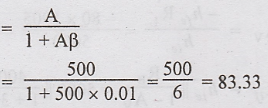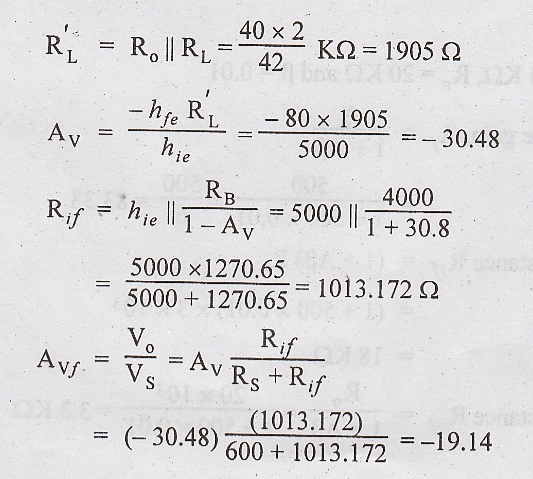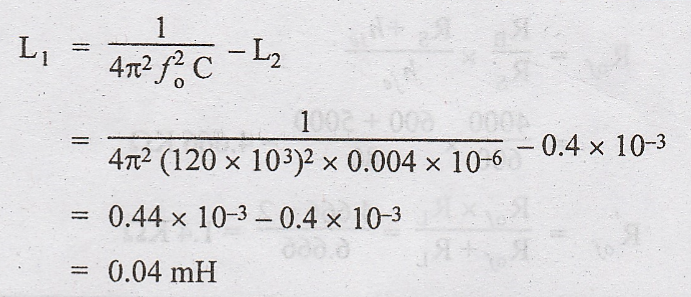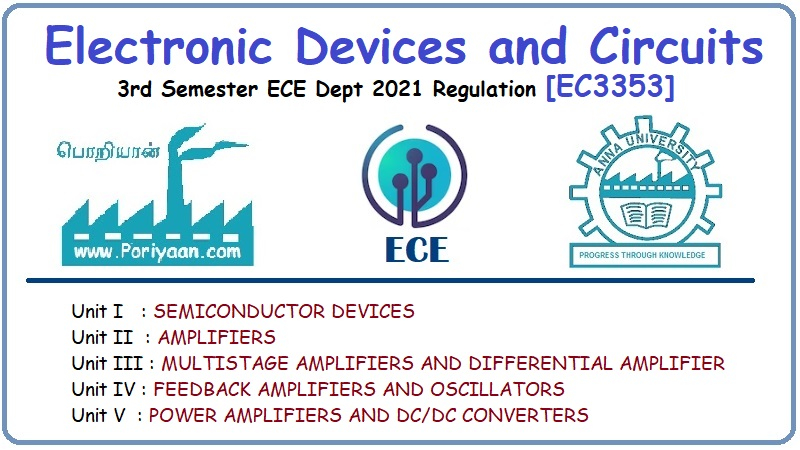Electronic Devices and Circuits: Unit IV: Feedback Amplifiers and Oscillators
Important Solved Problems of Feedback Amplifiers and Oscillators
Anna University Solved Problems
Anna university important solved Problems
SOLVED PROBLEMS
Problem 4.1
An
amplifier has an open-loop gain of 1000 and a feedback ratio of 0.04. If the
open loop gain changes by 10% due to temperature, find the percentage change in
gain of the amplifier with feedback.
Solution:
Given:
A
= 1000, β = 0.04 and dA/A = 10
The
percentage change in gain of the amplifier with feedback is

Problem 4.2
An
amplifier has a voltage gain of 400, f1 = 50Hz, f2 = 200
KHz and a distortion of 10% without feedback. Determine the amplifier voltage
gain f1f, f2f and Df when a negative feedback
is applied with feedback ratio of 0.01.
Solution:
Given:
A = 400, f1 = 50 Hz, f2 = 200 Hz, D = 10% and β = 0.01
Voltage
gain with feedback is

New
lower 3 dB frequency

New
upper 3 dB frequency

Distortion
with feedback

Problem 4.3
A
voltage-series negative feedback amplifier has a voltage gain without feedback
of A = 500, input resistance Ri = 3 KΩ, output resistance Ro
= 20 KΩ and feedback ratio β = 0.01. Calculate the voltage gain Af,
input resistance Rif and output resistance Rof of the
amplifier with feedback.
Solution:
Given:
A=500,
Ri = 3 KΩ, Ro = 20 KΩ and β = 0.01
Voltage
gain, Af 
Input
resistance Rif 
Output
resistance Rof 
Problem 4.4
An
emitter follower has RS = 600Ω, RL = 2 KΩ, hfe
= 80 and hie = 5 KΩ Calculate Ai, Ri, AV,
Ro and Rof.
Solution:

Problem 4.5
CE
amplifier with voltage-shunt feedback, has the following values of circuit
parameters, RS = 600Ω, hie = 5 KΩ, hfe = 80, RL
= 2 KΩ, RB = 40 ΚΩ Calculate AV, Rif, AVf,
Rof and R'of
Solution:


Problem 4.6
The
current series feedback type of transistor has the following parameters: R1
= 20 KΩ, R2 = 20 KΩ, hie = 2 KΩ, RL = 1 KΩ, Re
= 100 Ω and hie = 80. Calculate A, β, Rif, Af
and the loop gain in dB.
Solution:

Problem 4.7
In
a Hartley oscillator L2 = 0.4 mH and C = 0.004 μF. If the frequency
of the oscillator is 120 KHz, find the value of L1. Neglect the
mutual inductance.
Solution:
The
frequency of Hartley oscillator is given by


Problem 4.8
In
a Hartley oscillator, the value of the capacitor in the tuned circuit is 500PF
and the two sections of coil have inductances 38 µH and 12 µH. Find the
frequency of oscillations and the feedback factor β.
Solution:

Problem 4.9
In
a Colpitts oscillator, C1 = 0.2 μF and C2 = 0.02 μF. If
the frequency of the oscillator is 10 KHz, find the value of the inductor. Also
find the required gain for oscillation.
Solution:
The
frequency of the Colpitts oscillator is given by

The
voltage gain required to produce oscillation is

Problem 4.10
In
an RC phase shift oscillator, if R1 = R2 = R3
is 200 KΩ and C1 and C2 and C3 = 100 PF. Find
the frequency of oscillator.
Solution:

Problem 4.11
Determine
the frequency of oscillations when a RC phase shift oscillator has R = 10 KΩ, C
= 0.01 μF and RC = 2.2 KΩ. Also find the minimum current gain needed for this
purpose.
Solution:
The
frequency of oscillation is

For
sustained oscillations the minimum value of current gain or forward current
gain ratio hfe is

Problem 4.12
In
a Wien bridge oscillation, if the value of R is 100 KΩ, and frequency of
oscillation is 10 KHz, find the value of capacitor C.
Solution:
The
operating frequency of a Wien-bridge oscillator is given by

Problem 4.13
A
crystal has the following parameters L = 0.5 H, CS = 0.06 PF, CP
= 1 PF and R = 5 KΩ Find the series and parallel resonant frequencies and a
factor of the crystal.
Solution:
(a)
The series resonant frequency of the crystal is


(b)
The parallel resonant frequency of the crystal


Electronic Devices and Circuits: Unit IV: Feedback Amplifiers and Oscillators : Tag: : Anna University Solved Problems - Important Solved Problems of Feedback Amplifiers and Oscillators
Related Topics
Related Subjects
Electronic Devices and Circuits
EC3353 - EDC - 3rd Semester - ECE Dept - 2021 Regulation | 3rd Semester ECE Dept 2021 Regulation
